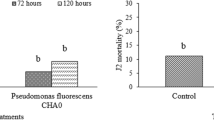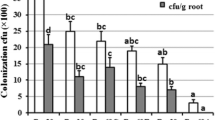Abstract
Lysis and viability of endoconidia ofThielaviopsis basicola artificially introduced into clay loam and sandy soil were microscopically examined at intervals. Most of the endoconidia remained morphologically unchanged in moist clay loam for more than one year, while in moist sandy soil all had disappeared by lysis within 4 months. One percent of the endoconidia that persisted for 15 months in clay loam germinated when tested with V-8 juice. Endoconidia transformed into chlamydosporelike structures when incubated in phosphate buffer solutions supplemented with glucose and asparagine but not in those without these compounds. The significance of these phenomena for the survival of the pathogen in soil is discussed.
Samenvatting
Kiemkracht en lysis van endoconidia vanThielaviopsis basicola gedurende een incubatieperiode van maximaal 15 maanden in luchtdroge en vochtige klei- en zandgrond werden microscopisch onderzocht. Het merendeel der endoconidiën in luchtdroge en vochtige kleigrond en in luchtdroge zandgrond onderging geen morfologische verandering gedurende de 10 maanden van incubatie, terwijl in vochtige zandgrond alle endoconidiën reeds binnen 4 maanden door lysis waren verdwenen. Eén procent van de endoconidiën bleek na een 15 maanden durende incubatie in vochtige kleigrond nog te kunnen kiemen. Van de endoconidiën die gedurende een verblijf van tween wintermaanden in zandgrond in het veld geen morfologische verandering ondergingen was eveneens nog 1% kiemkrachtig. Deze waarnemingen doen vermoeden, dat endoconidiën mede verantwoordelijk kunnen zijn voor de overleving vanT. basicola in natuurlijke grond. Omvorming van endoconidiën in chlamydospore-achtige structuren werd waargenomen in fosfaatbuffers waaraan glucose en asparagine was toegevoegd, echter niet in fosfaatbuffers zonder deze verbindingen. De vorming van deze structuren in natuurlijke grond kon niet worden aangetoond.
Similar content being viewed by others
References
Linderman, R.G. & Toussoun, T.A., 1967. Behaviour of chlamydospores and endoconidia of Thielaviopsis in non-sterilized soil. Phytopathology 57:729–731.
Mathre, D.E. & Ravenscroft, A.V., 1966. Physiology of germination of chlamydospores and endoconidia of Thielaviopsis basicola. Phytopathology 56:337–342.
Papavizas, G.C., 1968. Survival of root-infecting fungi in soil. VI. Effect of amendments on bean root rot caused by Thielaviopsis basicola and on inoculum density of the causal organism. Phytopathology 58:421–428.
Stover, R.H., 1950. The black root rot disease of tobacco. I. Studies on the causal organism Thielaviopsis basicola. Can. J. Res., C. 28:445–470.
Tsao, P.H. & Bricker, J.L., 1966. Chlamydospores of Thielaviopsis basicola as surviving propagules in natural soils, Phytopathology 56:1012–1014.
Author information
Authors and Affiliations
Rights and permissions
About this article
Cite this article
Schippers, B. Survival of endoconidia of Thielaviopsis basicola in soil. Netherlands Journal of Plant Pathology 76, 206–211 (1970). https://doi.org/10.1007/BF01974332
Accepted:
Issue Date:
DOI: https://doi.org/10.1007/BF01974332




